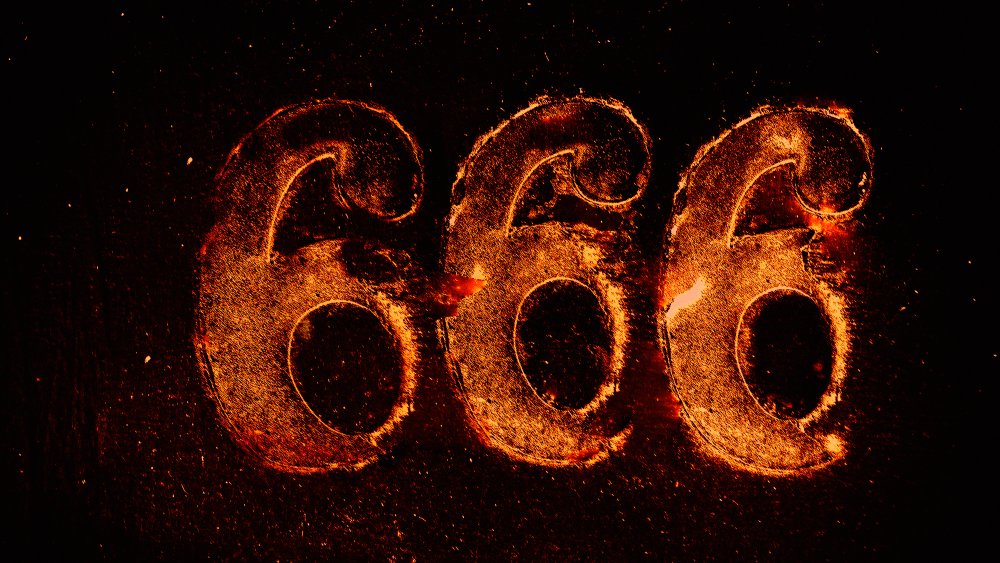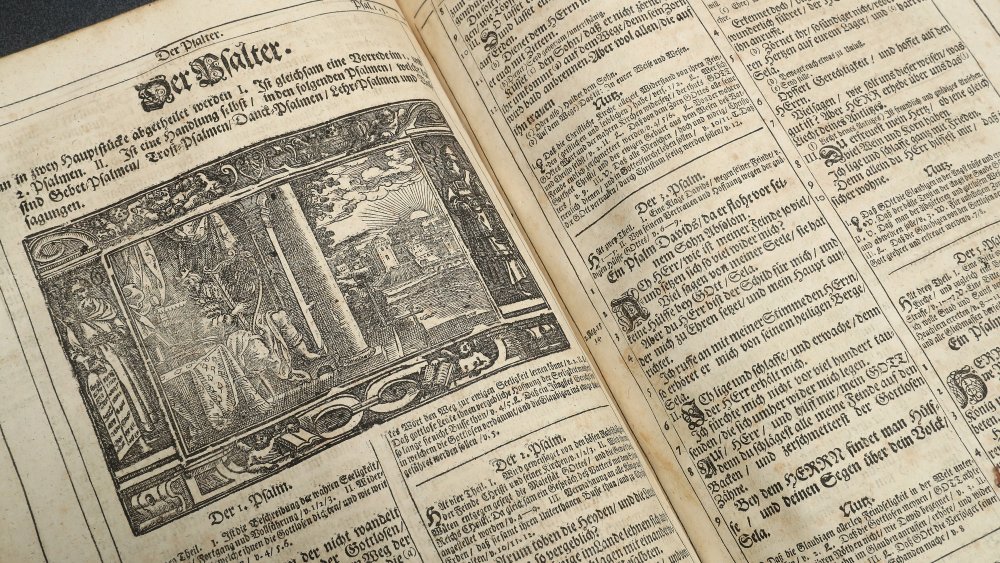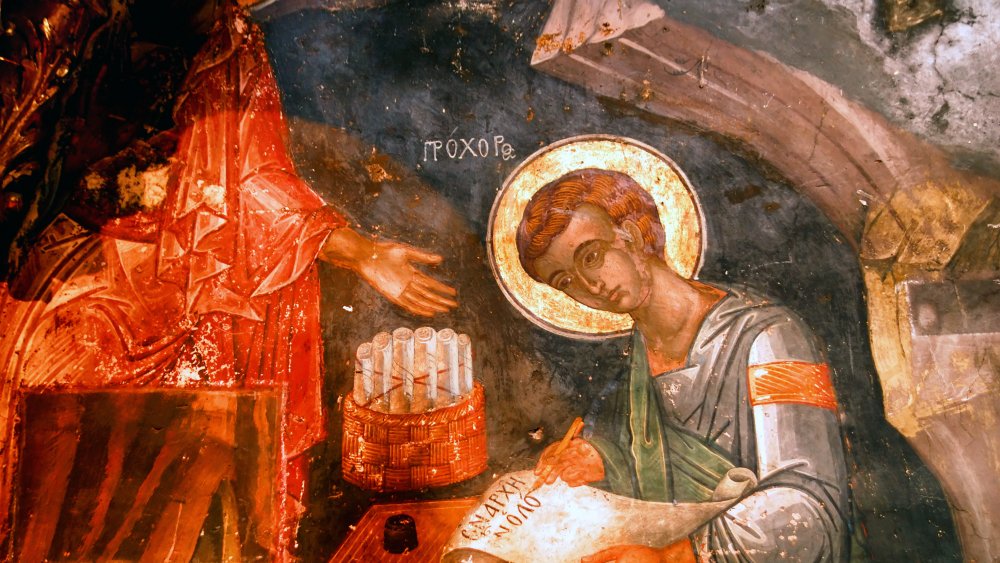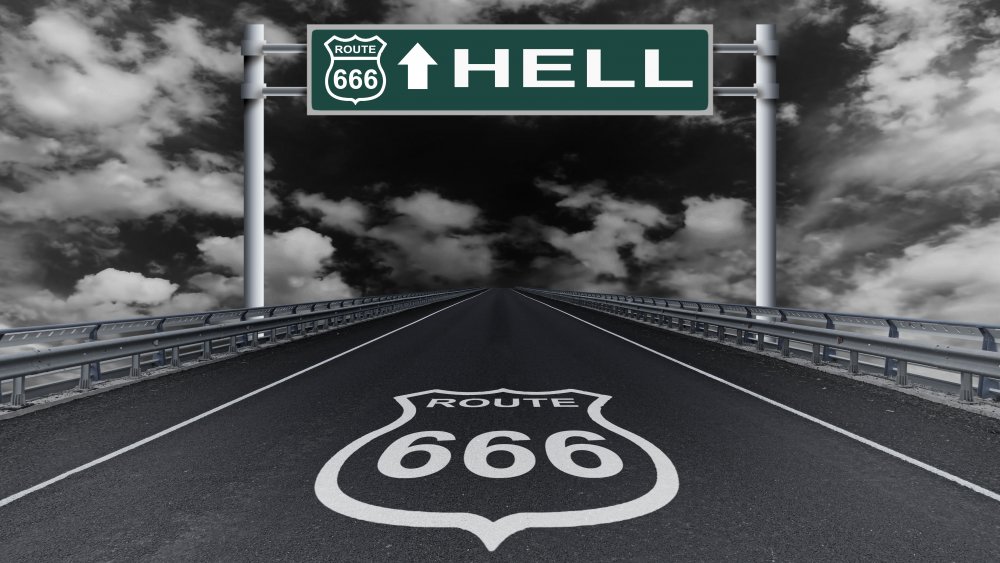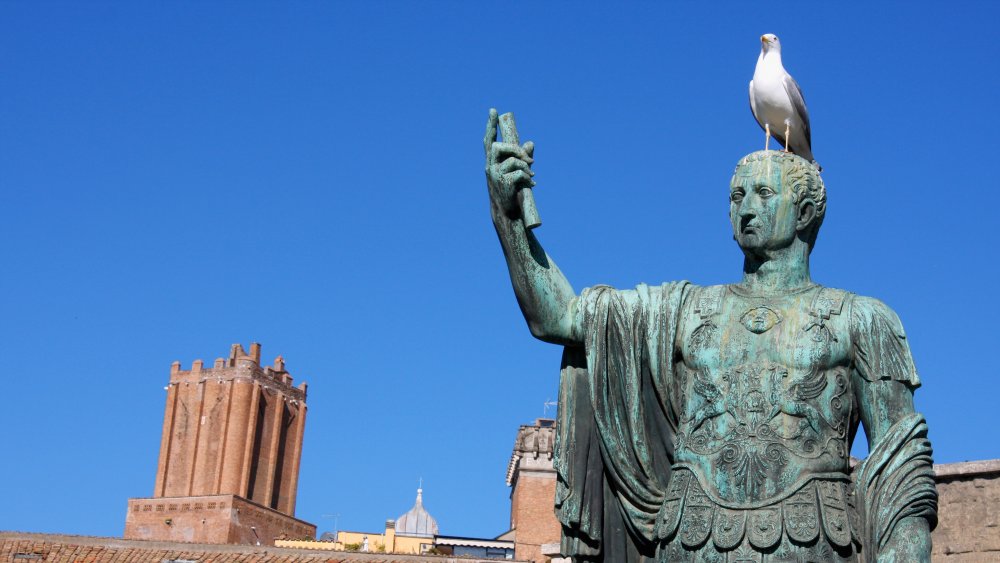The History Of The Number Of The Beast Explained
666.
Does that give you a bit of a chill?
There are many unlucky numbers around the world – in China, 4 is feared because it sounds like the word for death. In Japan, 9 sounds like the word for torture and suffering. And, of course, in many cultures, 13 is thought to be unlucky (not even for any particular reason – it's just not 12). But most "unlucky numbers" are just superstition. They sound like something, they're irregular, or they're just plain weird. 666 is unique among these numbers because it has a direct origin — it's the biblical "Mark of the Beast."
Most people know that 666 and the Mark of the Beast relate to biblical prophecy, but the history behind this belief is actually quite complex. When it comes to biblical scripture, there are layers of meaning rather than explicit answers. Biblical scholars must work from fragments of sacred texts, incorrect translations, and mistaken transcriptions — and from that, they need to interpret context and meaning from often dense symbolism. In recent history, 666 has become synonymous with the "Antichrist" and his followers, but that wasn't always true. So, before you go running the next time you see 666, you might want to learn a little more about the history of the number.
What exactly is the Number of the Beast?
The Number of the Beast is mentioned once and only once in the New Testament — in the Book of Revelation. In Revelation 13:18, the following passage appears: "Here is wisdom. Let him who has understanding calculate the number of the beast, for the number is that of a man; and his number is 666." What this means has, as with most of the Bible, been long argued — not least because translations themselves are imperfect.
First, the New Testament was written in Greek — and all the original copies were lost. Furthermore, as noted by The Aquila Report, the original copies of the New Testament had no paragraphs or punctuation, which means later translations had to get creative with interpretation. Over time, specific translations (such as the King James version) have become commonly accepted to be accurate — but often, biblical scholars need to go back to the earliest of texts for clarification.
As an example, in the Good News Translation, the passage instead reads: "This calls for wisdom. Whoever is intelligent can figure out the meaning of the number of the beast, because the number stands for the name of someone. Its number is 666." Why the difference? Because not only have the original texts been lost, but the texts available have ambiguous translations — especially due to the lack of punctuation, vowels, and context.
The Number of the Beast — the number of a man
In some translations, 666 is the number of a man. In others, it's simply a human number — as opposed to, say, a demon number. And in still others, it "stands for the name of someone," explicitly. But either way, 666 has culturally become synonymous with the mark of the Antichrist.
Surprisingly, this isn't supported by any actual biblical scripture. While the number 666 appears in the Book of Revelation, the Antichrist does not. Per the Catholic Standard, the Antichrist is never mentioned in the Book of Revelation, appearing instead in the Epistles of St. John. And when mentioned in the Epistles, it is noted that there are many Antichrists and that they already walk among us — in this context, it appears that "Antichrist" is being used as a word for heretics or deniers of Christ.
So, how did the Antichrist even come to exist, let alone be connected with the Number of the Beast? In the year 180, Iranaeus published Against Heresies — which combined the concept of an individual Antichrist with the number 666. From then on, the idea of an individual Antichrist who might someday come became a popular interpretation, even though a specific Antichrist is never mentioned in the New Testament texts. Eventually, it was simply accepted as biblical canon.
But in reality, there's no evidence that 666 (or the man referred to by the Number of the Beast) has anything to do with the Antichrist.
The Book of Revelation and the Number of the Beast
Why are there so many wildly different interpretations? It has to do with the way the Book of Revelation was written, which is unique to the New Testament.
There are New Testament scriptures dating back to circa 60 AD, but they're all in fragments. While it's believed that copies of the Bible date back to the time of Jesus, there aren't any full copies until well after. Many copies had to be cobbled together — some were written from memory, and some were incorrectly transcribed.
The Book of Revelation is the last book of the Bible, and it is believed to have been written around 95 AD, per PBS. It's notoriously difficult to decode because it relies heavily upon symbolism — in contrast to the other books. A simple example comes from the name of the book. While it's known as the "Apocalypse of John," this is likely to be another confusing mistranslation: In Greek, the word for "apocalypse" could denote a disclosure.
According to CNN, some believe that the Book of Revelation doesn't even describe a future apocalypse but rather an "apocalypse" that the writer had already personally experienced – the sacking and destruction of Jerusalem in 70 AD. And others point out that the Book of Revelation wasn't a singular artifact. There were many such books and apocrypha, but the Book of Revelation was chosen for inclusion into the biblical canon centuries after the books had been written.
There's even some debate whether the Number of the Beast is 666 or 616
In the old days, scholars needed to painstakingly transfer copies by hand, which means errors were introduced. Sometimes, those errors were small, and other times, they could be quite significant. So, it's perhaps not surprising that very early versions of the biblical manuscript have been discovered that record the Mark of the Beast as something entirely different – 616 rather than 666.
That could be a mistake in itself: A scribe could have written down 616 accidentally instead of 666. On the other hand, it could have originally been 616 all along and simply transferred as 666 because that number resonated more and appeared more foreboding. According to Medium, some even believe that 616 and 666 are both parts of a self-referential puzzle, though there's little evidence to that effect.
This leaves scholars with a lot to debate — the number 666 may or may not refer to the Antichrist, it may or may not deal with the apocalypse, and it may, in fact, be an entirely different number altogether.
In Islam, the Mark of the Beast is K-F-R
If the Mark of the Beast is an important revelation, one would expect it to show up in subsequent holy texts — and, in fact, it does.
Islamic writings, which originated centuries after the original scriptures, also contain the Mark of the Beast – but this time it's K-F-R. This represents the "deceiver" and is more clearly an Antichrist figure. As detailed by Britannica, al-Dajjal is a false messiah who will come to Earth before the apocalypse, only to be stopped by either Christ or the mahdī. K-F-R is written across his head: "unbelief." And there's even a description of him: a chubby, curly-haired man with a red face. Well, it's not a particularly foreboding description, but it's a description nonetheless.
Unlike the Book of Revelation (and the rest of the New Testament), which is fairly vague, the Islamic hadiths are extremely specific. The Antichrist has a wide forehead and a wide neck, he's short and strong, and he's sterile. More specifically, he is not symbolic of anything: It is made very clear that he is an actual man. Just as al-Dajjal expands on the Book of Revelation, cultural knowledge of the apocalypse has likely been influenced by ideas from Islamic scripture — these scriptures reaffirm the idea of an individual Antichrist. So, while there may have been no individual Antichrist in the books of the Bible, cultural mythology has been built.
Jehovah's Witnesses believe that the Number of the Beast denotes government control
On the other end of the spectrum, Jehovah's Witnesses believe that the Mark of the Beast does not indicate a single man but rather those who have become controlled by the government. This ties into the Jehovah's Witnesses' belief that those who are indoctrinated by the government are being led away from God.
To understand this, one must first look at the beginning of the relevant passages. So far, we've been talking about Revelation 13:18. But that's devoid of context. Now, let's take a look at Revelation 13:1: "Then I stood on the sand of the sea. And I saw a beast rising up out of the sea, having seven heads and ten horns, and on his horns ten crowns, and on his heads a blasphemous name."
Alright, well, that's not really that helpful to anyone — that's just weird. (Remember how we mentioned deep symbolism? There's also a part of Revelation that's about a dead lamb screaming and creatures that are chock full of eyes.) But under the interpretation of the Jehovah's Witnesses, Revelation 13:18 is a continuation of 13:1 — and the Number of the Beast refers to this beast. Witnesses believe that this beast refers to political systems, which can take control over people in place of God.
Some people have even believed that the Number of the Beast refers to the Pope
Since the original scripture was first penned, there have been many theories on who the Mark of the Beast refers to.
666 has become an easy way to demonize many highly public figures — and some have even deserved it. There have been those who have questioned whether Hitler bore the Mark of the Beast, as numerology could lead "Hitler" to mean "666." On the other hand, as noted by the St. Catherine of Siena Catholic Church, some have also accused the pope of bearing the Mark of the Beast, though he himself has refused donations in the number of 666.
Generally, accusations of being "the beast" rely on the fact that you can get any name to generate virtually any number if you try hard enough. Through complex mathematics, ciphers, and replacement theory, an individual can take literally any name and backward-compile it to suit the number that they want. And since the rest of the Book of Revelation is already so highly symbolic and up to interpretation, it becomes easy to slot just about anyone in.
But unfortunately, there's really no way of proving someone bears the Mark of the Beast until the apocalypse — at which point a "told you so" might seem shallow.
Some believed barcodes were the Mark of the Beast
Of course, we can't forget that the Mark of the Beast isn't necessarily the mark of a single person. There are still some who believe the Number of the Beast refers to those who follow the Antichrist rather than the Antichrist himself — or that the Antichrist would simply be connected to the number rather than bearing it.
And that means that the Mark of the Beast could be seen practically anywhere. Per Wired, even the now-ubiquitous UPC barcode was once said to represent 666 (though this was not only unlikely but also based on a misunderstanding regarding the way that the barcode is formatted). Under this interpretation, the Mark of the Beast becomes attached to consumerism — closer, now, to the interpretation of the Jehovah's Witnesses, relating to political theory. And that's not entirely outside of the cultural interpretation today.
The Mark of the Beast is often considered to be something that could be leading people astray — be it capitalism or technology. In the modern era, it makes sense that the Mark of the Beast would refer to technology or advancements that concern others. And it doesn't help that 666 has become popular in its own right.
Some even believed Monster Energy Drinks have the Mark of the Beast
With an upside-down cross apparently in the logo, it's perhaps not surprising that Monster Energy drinks have also been questioned as being part of the Mark of the Beast back in 2014, as reported by The Washington Post. And whether or not you approve of Monster Energy drinks, that's one of the most significant stretches in the history of 666. And that introduces a bit of a conundrum.
666 is now being widely used in alternative communities, such as metal music, Satanism, and goth subculture. So, even if the Mark of the Beast was once a relevant clue, it's now propagated to the point where it's more noise than signal. Ironically, it has become so popular specifically because of the text that told everyone to watch out for it. On June 6, 2006, the horror film The Omen took advantage of the date for its theatrical release. And according to The Salt Lake Tribune, some couples even intentionally chose that date for their weddings.
So how do you distinguish between the "real" Mark of the Beast and those who are just getting on the beastly hype train? Effectively, you don't — which is why so many people have been accused of bearing the mark.
In recent years, some have argued that Bill Gates bears the Number of the Beast
If anything is connected to the Antichrist, it has to be Microsoft, right?
First, the claim: "Microsoft holds patent 060606, a patent for microchips that can be embedded into people to track them!" That would be terrifying if it was true, but like most things that eventually end up on Snopes, it's mostly false. Microsoft holds patent WO02020060606A1, a number that (unfortunately) does not show up anywhere in any translation of the Bible. And it's just a patent for a smartwatch. But is it the Smartwatch of the Beast? No, no, it isn't.
The rumor started when the smartwatch patent (which does include three sixes) became conflated with the theory that Bill Gates is sneaking microchips into vaccinations. And paranoia about Bill Gates and vaccinations originated when he first mentioned that vaccinations could lead to a reduced population. Gates was talking about population control: When people know that their infants will survive to adulthood, they have fewer children as a whole. But some misinterpreted his off-the-cuff comment as meaning that the vaccinations themselves would sterilize or even kill people — certainly something the Antichrist might do.
Of course, Microsoft had 90,000 patents as of 2018. If it didn't hold 060606, it probably would have held 066006. Part of the allure — and frustration — of the Number of the Beast is that it's a pattern that can be easily reproduced virtually anywhere.
Many now avoid the Mark of the Beast entirely
A fear of the number 666 is referred to as hexakosioihexekontahexaphobia. But it's not referred to frequently. It's just too hard.
Many people, when running into 666, opt to change the number entirely – fearing it's unlucky even if it's not necessarily Satanic. (On the other hand, some have embraced it. When New Mexico's Route 666 changed its numbers, signs were raided as souvenirs.)
As pointed out by HowStuffWorks, numerical superstition is quite common. It's often implanted through a relationship — the number 13 can be considered to be unlucky because of the 13th apostle who betrayed Jesus. Then, it becomes reaffirmed through observation — the Apollo 13 mission fails, and the bad luck is affirmed. Since people are more likely to notice things that reaffirm their beliefs, they will slowly start to feel as though 13 really is the problem.
Similarly, the number 666 has become so culturally entrenched as an unholy, bad luck number that people can't help but feel wary about it — and when they feel wary about it, they are more likely to notice it around and more likely to attribute negativity to it.
Today, most scholars believe 666 was just a secret code
We've talked about how interpretation, translation, and even transcription matter. But now we should talk about context.
Bibles aren't just religious canon. They're also historical documents. When we read biblical scripture now, we naturally apply it to the modern era. But is a writer from 95 AD likely to have regarded Bill Gates as the Beast? Or would their Beast be a little closer to home?
This brings us to what most scholars today believe. In the original Hebrew, "666" is likely to have simply translated to "Nero Caesar." In other words, as noted by ScienceAlert, it might just be an ancient diss. The Book of Revelation isn't talking about an Antichrist. Instead, it's just talking about, well, someone who's a huge jerk. And that huge jerk could have been Nero. (What if it's really 616? There's an explanation for that, too: It would refer to Caligula.) This also explains something that hasn't been explained up until this point: why the passage begins by stating that the reader has to be clever. And that's why the Good News Translation explicitly states that it's the name of a man.
Regardless of whether the Mark of the Beast is the Antichrist, a sign of the apocalypse, or just an ancient jerk, the history behind it is quite fascinating — and it underscores the way that information can change due to translations, interpretation, and just time.
